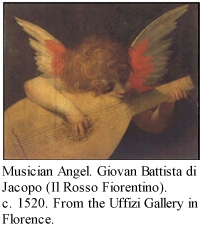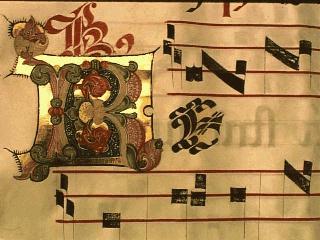The End of Europe's Middle Ages
| If you do not have an applicable plug-in, the audio files in this chapter can be heard with Crescendo 3.0 |
|
Musical developments in the later Middle Ages reflect changes in the political arena during that period. Secular lords were emerging from under the overarching influence of the Church and establishing their authority based on secular Roman and Common law. This movement away from the mystical religious world of the Church and towards the material and concrete world of earth penetrated the whole of medieval society, including its music. |
 |
|
 |
Early Medieval Sacred Music - Gregorian Chant | |
The beginnings of later medieval music can be traced to the Church. The papacy had always been a patron of the arts, especially during the Early and High Middle Ages when the Church dominated medieval life. The composers and innovators of the new musical trends were often church officers, but as the later Middle Ages progressed, composers increasingly came from secular backgrounds and the material world became the driving force behind artistic developments. Even musical styles were subject to this secularisation. For example, the motet, which originated in the religious music of the thirteenth century, quickly moved out of the church and into the courts of the nobility, becoming the dominant form of secular music in the fourteenth century. The motet became so unreligious that Pope John XXII issued a bull in 1326 forbidding the motet to be performed in churches.
 |
Development of the Motet |
 Detail of the Fesler Manuscript. Antiphonale-Responsoriale 16th Century Choir Book from Iberia. Hill Monastic Manuscript Library.
Detail of the Fesler Manuscript. Antiphonale-Responsoriale 16th Century Choir Book from Iberia. Hill Monastic Manuscript Library.
Although secular music experienced its most dramatic expansion in the eleventh century, and significant historical documentation is lacking before that time, it would be a mistake to think that secular music did not enjoy popularity before the High Middle Ages. The music of the people, musica civilis, was sufficiently common to draw disparagement from the early Church fathers and in the seventh century, another Church Father, St. Isidore of Seville (c. 560-636), made a study of musical instruments in two treatises. Musica rythmica investigated stringed and percussion instruments, while Musica organica covered the wind instruments. These studies included many instruments used only in secular music.
The rise of secular music was aided by the development of a corpus of Latin lyrical literature during the reign of Charlemagne (742-814) that included a collection of secular and semi-secular songs. Some scholars even played at setting to music the works of classical poets, such as Horace, Virgil, Cassiodorus, and Boethius. Secular music also benefited from the Goliards, itinerant monks and clerks who, although generally ostracised by the Church, provided popular entertainment across Europe.
While secular music in Latin was probably doomed to decline, music in the vernacular continued to grow and kept pace with the rapid expansion in vernacular literature. The chansons de geste were ideally suited to be set to music. The Goliards and jongleurs were a mixed crowd of travelling entertainers who reveal musical influences from as far away as Scandinavia and Egypt. These vagrant minstrels were the forerunners of the Trouvères, or Troubadours, who, adding the Arabian lyricism encountered in the Crusades to their creations, poured the excitement of chivalry into intensely beautiful music and poetry. Arising in south-west France during the twelfth and thirteenth centuries, the Troubadours praised both warlike heroism and sentimental passion.
 |
The Troubadours and Trouvères |
Still, Troubadour poetry and music were celebrations of chivalry and were therefore, by their very nature, limited to the aristocratic classes. Very few commoners were able to breach the walls of class and status, although Bernart de Ventadour's mother was a mere château servant. Eventually, however, the bourgeois tried to emulate the styles of the aristocrats and many composers and arrangers were non-nobles.
Many of the songs of the Troubadours were written down and, while the musical notations provide a faithful representation of the melodies, there is no indication of the rhythm, not surprising since the songs were still transmitted orally and the notations were only intended to assist the memories of the singers. Nevertheless, theorists have divided them into four main rhythmic modes that correspond to classical Latin poetic metres. These are:
- Litany - all verses are sung to the same melody, i.e. the chansons de geste.
- Hymn - the song consists of a continuous melody, without repetition.
- Sequence - a different melody is used every two verses, e.g. AA BB CC, etc. from which the instrumental lai and estampie probably developed.
- Rondeau - a song with a refrain, i.e. the virelai and the ballade.
 |
Development of Musical Notation |
Although its rise was most spectacular in England and France, the Troubadour influence was not limited to these countries. In the thirteenth century, both the Cantigas of Spain and the Italian laudes, which arose within St. Francis of Assisi's following can trace their origins to the virelai and rondels. The laudes especially were intended for use by a pious laity and are examples of the oldest compositions of spiritual music written in the vernacular. Originally simple monodies, by 1500 the laudes had evolved into complex polyphonic compositions.
In the fourteenth century, innovations signalled a new musical period identified as Ars Nova - the "new art" or "new technique" - by Philippe de Vitry (1291-1361), a poet and the bishop of Meaux, whom Petrarch (1304-1374) called "the greatest and the only poet" of his time. Vitry was a distinguished composer and theorist who made significant contributions to musical notation as well as to concepts of harmony and form.
The contributions made by Vitry were brilliantly applied by Guillaume de Machaut (1300-c.1372), the pre-eminent French composer of the period. His best known piece, Messe Notre-Dame, is the first polyphonic Mass composed entirely by a single author. It would take nearly a century for this feat to be matched. An impressive synthesis of traditional and modern musical styles, the Messe combined capricious rhythms, syncopation, hoquet, and imitation. This Mass is only a small part of the vast repertoire of Machaut's nearly 150 ballads, virelais, rondels, lais and motets that survive.
 |
Machaut- "De bonte, de valour"
Volume of file may have to be manually adjusted on console. |
Machaut's stature in the field of music underscore's France's acknowledged position as the cultural centre of Europe. Under the influence of chivalry and courtly love that originated in the courts of Provence, French cultural ascendancy radiated outwards, affecting many areas of life, including music. This primacy was further enhanced by the presence of the Papal court at Avignon from 1307 to 1377.
Machaut travelled widely, contributing to the growth of the Ars Nova. In Italy, composers and musicians quickly adopted Machaut's ideas and modified them into new and uniquely Italian forms. A common feature of Italian compositions was that the main melody was taken by the superius voice instead of by the tenor, as was usually done. The madrigal was a distinctly Italian form, while the Italian ballata traced its origins to the virelai and the caccia, or chasse, was related to the canon. The first generation of Italians included Jacopo da Bologna (fl.1346-1349) but Francesco Landino (c.1325-1397), who belonged to the next generation, was a consummate artist with both poetic and musical gifts. About 150 of his works have been preserved.
 |
Landino- "Questa fanciull' amor"
Volume of file may have to be manually adjusted on console. |
The Hundred Years War served to introduce the lighter and sweeter English musical form to the Continent. The Italians had produced no successor to Landino and French composers were mired in "sterilising complexities" when Englishman John Dunstable (1370?-1453) burst onto the scene with a fresh, new approach. Dunstable's influence prevailed throughout the first half of the fifteenth century and he employed all aspects of Continental techniques without subjecting his work to any single style.
 |
Anonymous- "Agincourt Carol"
Volume of file may have to be manually adjusted on console. |
|
 |
Dunstable- "Sancta Maria"
Volume of file may have to be manually adjusted on console. |
Dunstable's efforts provided the inspiration for two of the foremost composers of the later Middle Ages and early Renaissance, Binchois and Dufay, who again placed France on the path to cultural ascendancy. Gilles Binchois (1400-1460) trained at the cathedral of Cambrai, one of the foremost musical centres at the beginning of the fifteenth century. Composing both sacred and secular music, his songs were typically written for a solo voice accompanied by two instrumental parts.
Like Binchois, Guillaume Dufay (c.1400-1474) had also spent time at Cambrai but travelled far more widely and his music reflects the broader cultural experience. His works combined harmony and counterpoint into lively polyphonies, reflective of Dunstable's stylings. Dufay composed secular songs in a variety of styles but his best work was the sacred music in which he demonstrated intense emotion and consummate constructive skill. Dufay's fame spread quickly and he is credited, not always correctly, with numerous innovations in composition and notation.
 |
Binchois- "Files A Marier (chanson)"
Volume of file may have to be manually adjusted on console. |
|
 |
Dufay- "Virgine Bella"
Volume of file may have to be manually adjusted on console. |
Dufay lived to see renown come to his most famous pupil, Jan Ockenghem (c.1420-1495), who worked with him at Cambrai. In 1452, Ockenghem entered the service of the King of France and he remained at the French court until his death. The first to use imitation systematically, he left a large number of masses and motets as well as several songs.
The end of the fifteenth century was dominated by Josquin des Prez (c.1442-1524+), who is considered one of the greatest musicians in history. A prolific composer, Josquin left more than 29 masses, 119 motets and 86 secular works, including ballads and songs, nearly all written in vernacular French. As is common with many composers of the period, no matter how popular his secular works may have been, Josquin's sacred works are the most brilliantly executed. His early works follow the poyphonic tradition but, later, he sought freer and more spontaneous melodic compositions. Josquin's popularity served to make his pieces among the first musical scores to be printed.
 |
Des Prez- "Vive le Roy!"
Volume of file may have to be manually adjusted on console. |
Josquin and many of his contemporaries contributed to the development of a style of music called "chansons française" characterised by simpler and livelier rhythms. The polyphonic harmonies more closely follow the rhythms of speech and instrumental support is left behind. Nevertheless, instruments were commonly employed to fill in for missing voices and entire compositions were transcribed for instruments alone, especially the lute, organ and harpsichord.
 |
Instruments of the Middle Ages |
Music was profoundly affected by the changes that led to the Renaissance but while writers and philosophers turned to the ancient past for inspiration, composers and musicians sought new and freer methods of rhythmic expression that would set the tone for the Renaissance.
 |
Return to Visual Arts | Return to the Home Page |  |
The End of Europe's Middle Ages / Applied History Research Group / University of Calgary
Copyright © 1998, The Applied History Research Group